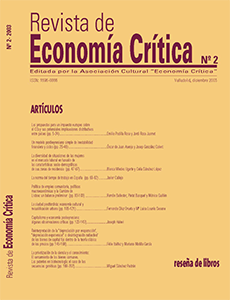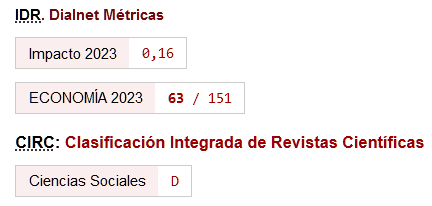La privatización de la ciencia y el conocimiento. El cercamiento de los bienes comunes. Las patentes en biotecnología: el caso de las secuencias genéticas
Keywords:
public good concept, knowledge as common propertyresource, patentsAbstract
The privatisation of unsuspected spheres of mankind’s common heritage has become thoroughly accepted in recent years. One of the main tools for opening the way and making such a privatisation legitimate is patents. However, an analysis of these legal instruments comes up against its inter-disciplinary nature. Three different areas come together in patents: economy, legislation and technology. The purport of this work is to construct a bridge between these areas. For this reason, the work is clearly differentiated in two parts. In the first, there is an examination of the notion of information as a public good, and there is an analysis of the concept of property in economy; these constitute the anchors of the exposition of the second part. This latter section addresses patents as legal instruments and expounds the legal requisites necessary for patenting an invention, and the problems encountered in the application of these requisites and principles in biotechnology. The basic message of this work has a twofold dimension. On the one hand, underlining the importance in current times of preserving the characteristics of knowledge as a common property resource; on the other, trying to show the need to extend, in some cases, and eradicate, in others, the perspective which leads to the supposition that all human interaction can be modellised as market interchange.
Downloads
References
ADLER, R.G. (1992): "Genome Research: Fulfilling the Public's Expectations for Knowledge and Commercialization", Science, August, vol. 257, 908-914. https://doi.org/10.1126/science.1502557
AGNEW, B. (2000): "Financial conflicts get more scrutiny in clinical trials", Science, 289, 1266-1267.
https://doi.org/10.1126/science.289.5483.1266
ALLEN, R.C. (1999): "Tracking the agricultural revolution in England". Economic History Review, 52(2), 209-235. https://doi.org/10.1111/1468-0289.00123
ALLEN, R.C. (2001): Revolución en los campos: La reinterpretación de la Revolución Agrícola Inglesa. Versión Castellana de C. Abadía. Universidad Pompeu Fabra. Conferencia inaugural del X Congreso de Historia Agraria. Sitges.
ARROW, K.J. (1962): "Economic welfare and the allocation of resources for invention" en Lamberton, D.M. (ed.): Economics of information and knowledge, Bungay, Suffolk. Penguin Education, 1971, 141-159.
ARUNDEL, A. (2000): "Patents - the Viagra of innovation policy?", Internal report to the expert group, Merit.
AYERS, P.J. (1999): "Armed and Ready: Defeating Patent Infringement Claims by Summary Judgment", Journal of the Patent and Trade Mark Office, June, 421-449.
BALTER, M. (2000): "France rebels against gene-patenting law", Science, 288, 2115.
https://doi.org/10.1126/science.288.5474.2115a
BARLOW, J. P. (1998): "Vender Vino", El paseante, la revolución digital y sus dilemas, 27-28.
BARTON, J.H. (1991): "Patenting Life", Scientific American, March, vol. 264(3), 18-24.
https://doi.org/10.1038/scientificamerican0391-40
BARTON, J.H. (1995): "Patent Scope in Biotechnology", The International Review of Industrial Property Right and Copyright Law (IIC) , vol. 26(5), 605-618.
BEIER, F.K. (1986): "The inventive step in its historical development", IIC, Vol. 26, nº 5, 605-618.
BERCOVITZ RODRÍGUEZ-CANO, A. (1994): "La Ley Española de Patentes", en Centro de Estudios para el Fomento de la Investigación (CEFI) Reflexiones sobre la protección de la investigación en el umbral del 2000, Barcelona. CEFI, 1994, 101-119.
BERRIER, E.F. (1996): "Global patent costs must be reduced", IDEA, vol. 36(4), 473-499.
BOLLIER, D. (2001): Public Assets, Private Profits. New American Foundation. Washington. www.newamerica.net/events/transcript texts/PA Report
BOYLE, J. (1992): "A theory of law and information: copyright, spleens, blackmail and insider trading", California Law Review, 87, 1413-1490. https://doi.org/10.2307/3480824
BOYLE, J. (1996): Shamans, software & spleens. Law and the construction of the information society, Harvard University Press. https://doi.org/10.4159/9780674028630
BOYLE, J. (1997): "A politics of Intellectual Property: Environmentalism For the Net?", Duke Law Journal, 87, 87-102. https://doi.org/10.2307/1372861
BUCHANAN, J.M. (1987): "The Constitution of Economic Policy", American Economic Review, Vol.77, 243-250.
CAMBROSIO, A., P. KEATING AND M. MACKENZIE (1990): "Scientific Practice in the Courtroom: the Construction of Sociotechnical Identities in a Biotechnology Patent Dispute", Social Problems, vol. 37(3), 275-293. https://doi.org/10.1525/sp.1990.37.3.03a00010
COHENDET, P., MEYER-KRAHMER, F. (2001): "The Theoretical And Policy implications of knowledge Codification", Research Policy 30, 1563-1591. https://doi.org/10.1016/S0048-7333(01)00168-8
COOPER, C.C. (1991): "Social Construction of invention through patent management: Thomas Blanchard's Woodworking Machinery", Technology and Culture, vol. 32(4), 960-998. https://doi.org/10.1353/tech.1991.0005
CORNISH, W. (1996): Intellectual property: patents, copyright, trade marks and allied rights, Sweet & Maxwell.
CRESPI, S. (1995): "Biotechnology Patenting: The Wicked Animal Must Defend Itself", EIPR, 9, 431-441.
DASGUPTA, P. (1987): "The Economic Theory of Technology Policy", en P. Dasgupta y P. Stoneman, ed, Economic Policy and Technological Performance, Cambridge University Press. https://doi.org/10.1017/CBO9780511559938
DAVID. P.A. (1993): Knowledge, Property, and the Systems Dynamics of Technological Change, Proceedings of the World Bank Annual Conference on Developments Economics 1992. Washington. The World Bank. https://doi.org/10.1093/wber/6.suppl_1.215
DEMSETZ, H. (1967): "Toward a theory of property rights", American Economic Review, vol. LVII (2), 347-359.
DICKINSON, Q. (2000): "Commissioner's Page", March, Patent and Trademark Office Today, 2-4.
DÍEZ-PICAZO L Y GUILLÓN, A. (2001): Sistema de derecho civil. Vol.3, Editorial Tecnos.
DOSI, G. (1982): "Technological paradigms and technological trajectories: A suggested interpretation of the determinants and directions of technical change". Research Policy,11, 147-162. https://doi.org/10.1016/0048-7333(82)90016-6
DRAHOS, P.A (1996): Philosophy of intellectual property, Dartmouth Publishing Company Limited, England.
DRAHOS, P.A. (1999): "Biotechnology Patents, Markets and Morality", European Intellectual Property Review 9, 441-449.
EUROPEAN PATENT OFFICE (2000): Annual Report.
EUROPEAN PATENT OFFICE (2000): Guidelines for Substantive Examination, Accessible en www:european-patent-office.org.
DRAHOS, P.A. CON BRAITHWAITE, J. (2002): Information Feudalism. Who owns the Knowledge Economy. Earthscan.
FRANZOSI, M Y DE SANCTIS (1995): "Moral Rights and New Technology: are Copyright and Patents Converging?", European Intellectual Property Review 2, 63-66.
FURUBOTN, E. Y G. PEJOVICH (1972): "Property Rights and Economic Theory: A Survey of Recent Literature", Journal of Economic Literature Vol.10,1137-1162.
GOLDBERG, V.P. (1974): "Public Choice-Property Right", Journal of Economics Issues 8(3), 555-579.
https://doi.org/10.1080/00213624.1974.11503208
GRINDLEY, P.C. Y D.J. TEECE (1997): "Managing Intellectual Capital: Licensing and Cross-licensing in semiconductors and electronics", California Management Review, Winter, vol.39(2), 3-41.
https://doi.org/10.2307/41165885
HARDIN, G. (1998): "Extensions of "The Tragedy of the Commons" ", Science, vol. 280, 682-683.
https://doi.org/10.1126/science.280.5364.682
HELLER, M.A. AND R.S. EISENBERG (1998): "Can Patents Deter Innovation? The Anticommons in Biomedical Research", Science, vol. 280, 98-701. https://doi.org/10.1126/science.280.5364.698
HELLER, M.A. (1998): "The tragedy of the anticommons: property in the transition from Marx to Markets". Harvard Law Review, vol.111, nº3, 621-688. https://doi.org/10.2307/1342203
IGLESIAS PRADA, J.L. (1995): La Proteccion Jurídica de los Descubrimientos Genéticos y el Proyecto Genoma Humano. Madrid. Civitas.
INFORME DE DESARROLLO HUMANO (1999), Editorial Mundi-prensa.
ISIS (2003): Canada Rejects Patents on Higher Live Forms, www.i-sis.org.uk.
KAPLINSKY, R. (1992): "Derechos de propiedad industrial e intelectual a partir de la Ronda Uruguay en El Cambio Tecnológico hacia el nuevo milenio", Mikel Gómez Uranga. Miguel Sánchez Padrón y Enrique de la Puerta (comp.), Barcelona, Icaria.
KARNELL,G.W.G. (1995): "Protection of Results of Genetic Research by Copyright or designRights?" European Intellectual Property Review 8, 355-358.
LANGE, D. (1981): "Recognizing the public domain", Law and Contemporary Problems. Vol 44, No.4, 147-178. https://doi.org/10.2307/1191227
LESGARDS, R (1998): "Refundar el derecho de propiedad". Le Monde Diplomatique en español, Diciembre.
LESSIG, L. (2001): The Future of Ideas. Random House. New York.
LITMAN, J. (1990): "The Public Domain", Emory Law Journal, vol. 39(4), 965-1023.
MACHLUP, F. Y PENROSE, E. (1950): "The patent controversy in the Nineteenth century", The Journal of Economic History, vol. X, nº1, Mayo 1950. https://doi.org/10.1017/S0022050700055893
MACHLUP, F. (1958): An economic review of the patent system. Study nº 15. U.S. Senate.
MARX, K. (1967): El Capital. E.D.A.F.
MAYHEW, A. (1985): "Dangers in Using the Idea of Property Rights: Modern Property Rights Theory and the Neo-Classical Trap", Journal of Economic Issues XIX, 4, 959-966.
https://doi.org/10.1080/00213624.1985.11504447
MERGES, R.P. (1991): "A brief Note on Blocking Patents and Reverse Equivalents: Biotechnology as an Example", Journal of the Patent and Trade Mark Office November, 878-888.
NATURE (2000): "Bad clinical practices", Nature, vol. 405, 29 June, 981. https://doi.org/10.1038/35016694
NELSON, R. (1989): "What is private and what is public about technology", Science, Technology & Human Values, 14 (3), 229-241. https://doi.org/10.1177/016224398901400302
NORTH, D.C. (1994): "Economic performance through time", American Economic Review, 84(3), 359-368.
OVEJERO LUCAS, F: (2003): "Las Matemáticas de la Economía", Claves, nº136, 48-52.
RIFKIN, J. (1999): El siglo de la Biotecnología. Crítica-Marcombo.
RANDALL, A. (1978): "Property Institutions and Economic Behavior", Journal of Economics Issues, 12(1), 1-21. https://doi.org/10.1080/00213624.1978.11503502
ROMER, P.M. (1990): "Are nonconvexities important for understanding growth?", American Economic Association Papers and Proceedings, 80(2), 97-103. https://doi.org/10.3386/w3271
ROMER, O. (1993): "Implementing a National Technological Strategy with Self-Organizing Industry Investment Boards". Brookings Papers: Microeconomics 2, 345-399. https://doi.org/10.2307/2534742
ROSE, C. (1986): "The Comedy of the Commons: Custom, Commerce and Inherently Public Property", The University of Chicago Law Review, 53(3), 711-781. https://doi.org/10.2307/1599583
ROSENBERG, L. E. AND A.N. SCHECHTER (2000): "Gene Therapist, Heal Thyself?", Science, vol. 287, 1751. https://doi.org/10.1126/science.287.5459.1751
RYAN, A. (1991): "Property", The New Palgrave a Dictionary of Economics, MacMillan Press.
SÁNCHEZ, M., V. CANO AND E. LOS ARCOS (1996): "An analysis of EPO renewals: a first step towards patent value estimation. Some conceptual considerations", Paper presented in the 54th International Conference for the Applied Econometrics Association, Luxemburg, (Working Paper 98/99-03, La Laguna, 1999).
SÁNCHEZ, M. Y URANGA, M. (2001): "The institutional choice in biotechnology: Patents and ethics", Journal of Economics Issues, XXXV (2), 315-322.
SANTOS PASTOR (1989): "Formas de propiedad y análisis económico del derecho: ¿nuevas luces a viejas sombras", Economistas, nº 38, 28-31.
SCIENCE (2000): "Genetic Benefit Sharing", Science, Vol. 290,49. https://doi.org/10.1126/science.290.5489.49
SEN, A. (1976): "Rational fools: A critique of the behavioral foundations of economic theory", reproducido en Nueva Economía del Bienestar. Escritos Seleccionados, 1995. Universitat de Valencia.
SEN, A. (1980): "The impossibility of a paretian liberal" reproducido en Nueva Economía del Bienestar. Escritos Seleccionados, 1995,Universitat de Valencia.
SEN, A. (2000): Desarrollo y Libertad. Planeta.
SPECK, A. (1995): "Genetic Copyright. ?" European Intellectual Property Review 4,71-173.
SULSTON, J Y FERRY, G (2003): El Hilo Común de la Humanidad. Una historia la ciencia, la política, la ética y el genoma humano. Siglo XXI de España.
VENTER, J.C. (1995): "The patentability of genetic discoveries", The Human Genome Project: Legal Aspects, Volume II. Fundación BBV, 123-126.
WELLS, A.J. (1994): "Patenting New Life Forms: An Ecological Perspective", EIPR, 3, 111-118.
Downloads
Published
How to Cite
Issue
Section
License
This licence allows third parties to share (copy and redistribute the material in any medium or format) and adapt (remix, transform and create from the material for any purpose, including commercial purposes), provided that authorship and first publication in this journal (The Journal, DOI of the work) is acknowledged, a link to the licence is provided, and it is stated whether changes have been made to the work.







